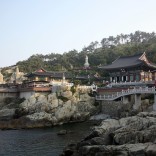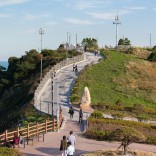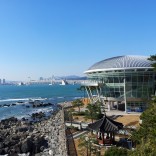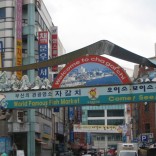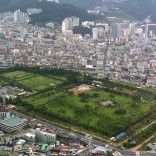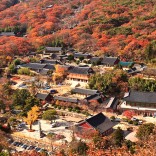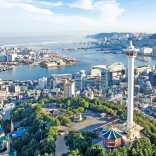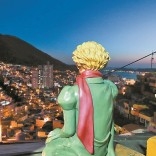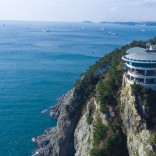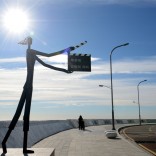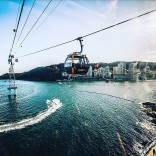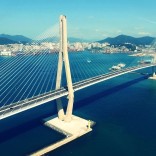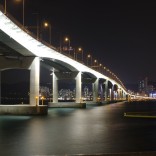Tourist spots
Haedong Yonggungsa Temple
| Address | 86, Yonggung-gil, Gijang-eup, Gijang-gun, Busan |
| Inquiries | +82-51-722-7744 |
| Homepage | http://www.yongkungsa.or.kr |
Haedong Yonggungsa Temple is situated on the coast of the north-eastern portion of Busan. This superb attraction offers visitors the rare find of a temple along the shore line; most temples in Korea are located in the mountains. Haedong Yonggungsa Temple was first built in 1376 by the great Buddhist teacher known as Naong during the Goryeo Dynasty. Haesu Gwaneum Daebul (Seawater Great Goddess Buddha), Daeungjeon Main Sanctuary, Yongwangdang Shrine, Gulbeop Buddhist Sanctum (enclosed in a cave), and a three-story pagoda with four lions can all be seen looking out over the ocean.
The main sanctuary of the temple was reconstructed in 1970 with careful attention paid to the colors that were traditionally used in such structures. On the right-hand side, inside the a cave, is a uniquely designed Buddhist sanctum, while situated just in front of the main sanctuary is a three-story pagoda with four lions. The four lions are symbolizing joy, anger, sadness, and happiness. Other special sites at the temple are the 108 stairs and stone lanterns lining the rocky landscape. After going down the 108 steps, one will be delighted with the beauty of the temple. Midway down the 108 steps one can stop and enjoy the calming sounds of the waves, and view the majestic sunrise.
Many people often come to this spot on New Year's Day to make a wish for the new year as they watch the sun come up. April is an especially beautiful time of year with cherry blossoms in full bloom. The birth of Buddha is also celebrated in the fourth month of the lunar calendar and offers a spectacular night view as the temple area is aglow with lit lanterns.
Oryukdo Skywalk
| Address | 137, Oryukdo-ro, Nam-gu, Busan |
| Inquiries | +82-51-607-6395 |
| Homepage | http://www.bsnamgu.go.kr |
The regional name in olden times for the area of Oryukdo Skywalk was Seungdumal (승두말), as the shape resembles a saddle, and it was originally called Seungduma (승두마) as well as Jallokgae (잘록개) by residents and women divers.
The construction of Oryukdo Skywalk finished on September 12, 2012 at the Seungdumal area, which is regarded as the dividing point between the East Sea and the South Sea, and started operating on October 18, 2013, with the theme of "Walking over the sky.”
Iron columns were set up over a 35-meter-high coastal cliff, and a 15-meter glass bridge comprised of 24 glass plates and shaped like a horse’s hoof connect the iron columns. The bottom of the glass was specially produced with four attached 12-millimeter glass pieces coated with a bulletproof film that has a thickness of 55.49 millimeters, making the structure quite safe.
Visitors will be thrilled with the view of the waves while looking down through the transparent floor. The sea stretches out ahead of the skywalk, perfect for a photo op, as well as the best spot to see Daemado Island on sunny days.
Nurimaru APEC House
| Address | 116, Dongbaek-ro, Haeundae-gu, Busan |
| Inquiries | +82-51-744-3140 |
| Homepage | http://www.busan.go.kr/nurimaru |
The name Nurimaru APEC House is created by combining the Korean words nuri (“world”) and maru (“summit”), and “APEC House,” which refers to an APEC conference hall. Collectively, it means “a house where the world summits gather together for an APEC meeting.”
Located on Dongbaekseom Island, which is noted for its beautiful, natural landscape accented by dense camellia and pine trees, Nurimaru APEC House has been used as a memorial hall and a prestigious international conference hall since the APEC summit meeting. Nurimaru, a 3-story building, is a modernistic expression of “jeongja,” a pavilion in traditional Korean architectural style. Its roof shape symbolizes the ridgeline of Dongbaekseom Island. Its interior design is a visual display of Korea’s creative traditional culture.
The terrace, which has a Korean wooden floor concept, towers over Oryukdo Island, Gwangan Bridge and Dallmaji Hill. Located near Haeundae Beach, it not only offers a spectacular view of the beach, but also has the appearance of a reputable international conference hall featuring both modern and natural beauty.
Jagalchi Market
| Address | 52, Jagalchihaean-ro, Jung-gu, Busan |
| Inquiries | +82-51-713-8000 |
| Homepage | http://jagalchimarket.bisco.or.kr |
Jagalchi Market, located on the shoreside road in Busan's Jung-gu, is Korea's largest seafood market, selling both live and dried fish. After the Korean War the market solidified itself as a fish market. Most of the people who sell fish are women, so the vendors here are called Jagalchi Ajumma, "ajumma" meaning middle-aged or married woman in Korean.
This market represents Busan and is famous throughout the country. If you visit you can eat fresh raw fish right at the market. Even these days you can see women selling mackerel, sea squirts (ascidians) and whale meat on wooden boxes along the road outside of the market and along the shore.
Every year in October the Jagalchi Cultural Tourism Festival is held, and it is easy to visit because of the convenient transportation provided by subway. Jagalchi Market is where you can see the lifestyle of the Busan locals.
UN Memorial Cemetery in Korea
| Address | 93, UN pyeonghwa-ro, Nam-gu, Busan |
| Inquiries | +82-51-625-0625 |
| Homepage | http://www.unmck.or.kr |
The UN Memorial Cemetery in Korea honors UN soldiers from 16 countries and UN aids from five countries that were killed in battle during the Korean War from 1950-1953. This serene park spreads across a grassy plain area of 135,000 square meters. Some notable sites and memorials include: Memorial Service Hall, Memorabilia Hall, two Turkish Monuments, Greek Monument, Australian Monument, British Common Wealth Monument and two ponds. The Memorial Service Hall and the Memorabilia Hall were constructed in 1964 and 1968 respectively. The citizens of Busan dedicated the Main Gate in 1966. There are many annual events held here such as April’s Tributary Ceremony of the Veterans of the Korean War, May’s American Memorial Day, June’s Korean Memorial Day, and October’s UN Ceremony Day.
Beomeosa Temple
| Address | 250, Beomeosa-ro, Geumjeong-gu, Busan |
| Inquiries | +82-51-508-3122 |
| Homepage | http://www.beomeosa.co.kr |
Beomeosa Temple is located at the eastern edge of Geumjeongsan Mountain, a famous mountain in Busan. It was constructed by monk Ui Sang in the 678, the 18th year of King Munmu (r. 661-681) of the Silla Kingdom. It is one of the three most famous temples in the Yeongnam region, along with Haeinsa Temple and Tongdosa Temple.
Most of the original Beomeosa Temple site was lost during the Imjin War (1592-1598) but was restored in 1613 and has remained until now. Daeungjeon Hall is one of the most delicate and luxurious architectures of the Joseon Dynasty. Other important sites of the temple include Iljumun Gate, a three-story pagoda with four pillars built in the 9th century; pavilions, gates, and eleven hermitages. Designated as a natural monument, the wisteria woods and valleys around the temple are most beautiful in May. Beomeosa Temple also operates a templestay program for visitors to learn more about the Buddhist culture and discover oneself.
Yongdusan Park (Busan Tower)
| Address | 37-55, Yongdusan-gil, Jung-gu, Busan |
| Inquiries | +82-51-661-9393 |
| Homepage | http://yongdusanpark.bisco.or.kr |
Busan Tower is a symbol of Busan that stands proudly 69 m above sea level at a height of 120 m. The top of the tower is modeled after the baldaquin of Dabotap Pagoda in Bulguksa Temple, Gyeongju.
Beloved by Busan citizens and tourists alike, the tower offers a stunning night view and plenty to see, such as the Statue of the Great Admiral Yi Sun-sin, the Bell of the Citizens, a flower clock and a bust of the Busan-based independent activist, Baeksan An Hee-je.
Gamcheon Culture Village
| Address | 203, Gamnae 2-ro, Saha-gu, Busan |
| Inquiries | +82-51-291-1444 |
| Homepage | http://www.gamcheon.or.kr |
Gamcheon Culture Villiage is formed by houses built in staircase-fashion on the foothills of a coastal mountain, earning this village the nickname of "Machu Picchu of Busan." The many alleys cutting through this community are vibrantly decorated with murals and sculptures created by the residents.
Taejongdae
| Address | 24, Jeonmang-ro, Yeongdo-gu, Busan |
| Inquiries | +82-51-405-2004 |
| Homepage | http://taejongdae.bisco.or.kr |
The Street of Cinema
| Address | Udong, Haeundae-gu, Busan (Marine city) |
| Inquiries | |
| Homepage |
The street of cinema were constructed after Haeundae District was elected a project to activate the tourism special zone under the Ministry of Culture, Sports and Tourism.
Under the theme of " Play and Enjoy with Movies", there are three main themes : "10 million audience movie Zone", "Animated Zone" and "Zone of films set in Haeundae" and "Fantastic Art Photo Zone" which is filled with fantastic artwork, Santorini Square, and hand printing.
Songdo Air Cruise / Cloud Walk
| Address | 171, Songdohaebyeon-ro, Seo-gu, Busan |
| Inquiries | +82-51-247-9900 |
| Homepage | http://www.busanaircruise.co.kr |
[Songdo Maritime Cable Cars]
* Flight in 29 years *
To remember your happy life, Songdo Island, Busan Air Cruise is leaving for another flight.
The Songdo Maritime Cable Car - Busan Air Cruise, which is to be restored after 29 years, opened its restoration project in 2017 by injecting 70 billion won into the entire project to revive the reputation of Korea's first public beach, Songdo Beach.
Busan Air Cruise operates 39 eight-seat cabins, including crystal cabins, which are located at the bottom of 1.62 kilometers from Songrim Park to Amnam Park, east of the beach. All cabins are the latest model in their kind in Korea, and they are also made of 10 seats, providing customers with a more relaxed and comfortable boarding conditon.
In particular, you can enjoy the thrill in the middle of the sea by driving across the ocean from up to 86 meters high, and the spectacular scenery stretches down to Amnam Park, Namhang Port, and Yeongdo Island.
Busan Air Cruise also plans to offer various other premium attractions, including the first cable car museum in Korea called Songdo Dopelmeier World, Asia's first swing with Sky Swing, and theme park's photo service.
To remember your happy life, Songdo Island, Busan Air Cruise is leaving for another flight.
[Songdo Cloud Walk]
The Songdo Cloud Walk is a 365-meter walk along the skywalk lying above the sea at Songdo Beach.
Gwangandaegyo Bridge (Diamond Bridge)
| Address | 203, Suyeonggangbyeon-daero, Haeundae-gu, Busan |
| Inquiries | +82-51-780-0077 |
| Homepage | http://www.gwanganbridge.or.kr |
Busan Gwangandaegyo Bridge (Busan 66, also called Gwangan-daero) stretches over 7.4km from Namcheon-dong (Suyeong-gu, Busan) to Centum City (U-dong, Haeundae-gu). It is the longest bi-level bridge over the ocean in Korea. In addition to providing a quick way to get around, the bridge offers breathtaking views of nearby attractions, including the endlessly unfolding ocean, Oryukdo Island, Hwangnyeongsan Mountain, Gwangalli Beach, Dongbaekseom Island, and Dalmaji Hill.
Equipped with thousands of LED lights, the bridge showcases a beautiful lighting exhibition at night that changes with the seasons. The bridge offers a majesty beauty when combined with nearby attractions during the day and a romantic atmosphere at night, attracting many residents and tourists.
Busanhangdaegyo Bridge
| Address | Gamman-dong, Nam-gu, Busan |
| Inquiries | +82-1544-3888 |
| Homepage | http://www.bukhangbr.com |
Busan Harbor Bridge, connecting Cheonghak-dong and Gamman-dong, Yeongdo-gu, Busan, is the nation's longest composite cable-stayed bridge measuring 3,330m in length and 18.6~28.7m in width. Cable-stayed bridge means a bridge in which the cables holding the top are installed in a diagonal line and symmetrical in relation to the tower. Busan Harbor Bridge is 60 to 66 meters high between the surface of the sea and the bottom of the bridge, allowing passengers to safely pass through international passenger terminals and through North Port and container ships.
The design and manufacture of large container ships in and out of the North Harbor, and preventing accidents such as typhoon damage, were considered in the design and construction of the city and sea areas. It will install 2,076 LED lights to provide scenic lighting under the theme of 'Fourseasons of Lights', creating a beautiful night view. It is also expected to make a significant contribution to the tourist attractions as well as smooth transportation of port traffic, easing traffic congestion in the city and reducing logistics costs.
Namhangdaegyo Bridge
| Address | Namhangnam-ro, Yeongdo-gu, Busan |
| Inquiries | +82-51-231-2293 |
| Homepage | http://gwanganbridge.bisco.or.kr/about/about01/about01_2 |
Namhang Bridge is a 1.9-kilometer-long bridge connecting Yeongseon-dong and Amnam-dong in Yeongdeung-gu, Busan. Namhangang Bridge, which opened in July 2008, is a 1994-1 meter long and 25.6 meter wide sea bridge connecting Amnam-dong in the West and Yeongseon-dong in Yeongdo-gu.
And lights under the theme of 'Gate to Open the New World' are beautifully embroidered on the night sea in Namhang Port, setting up a 3-meter-wide walking trail along the coast of Busan to allow citizens to freely visit the port.

